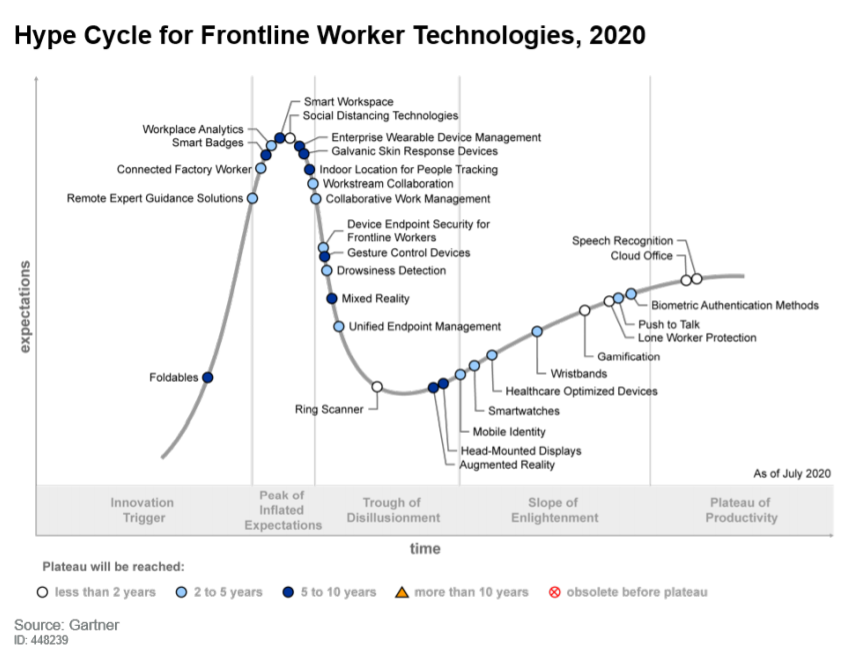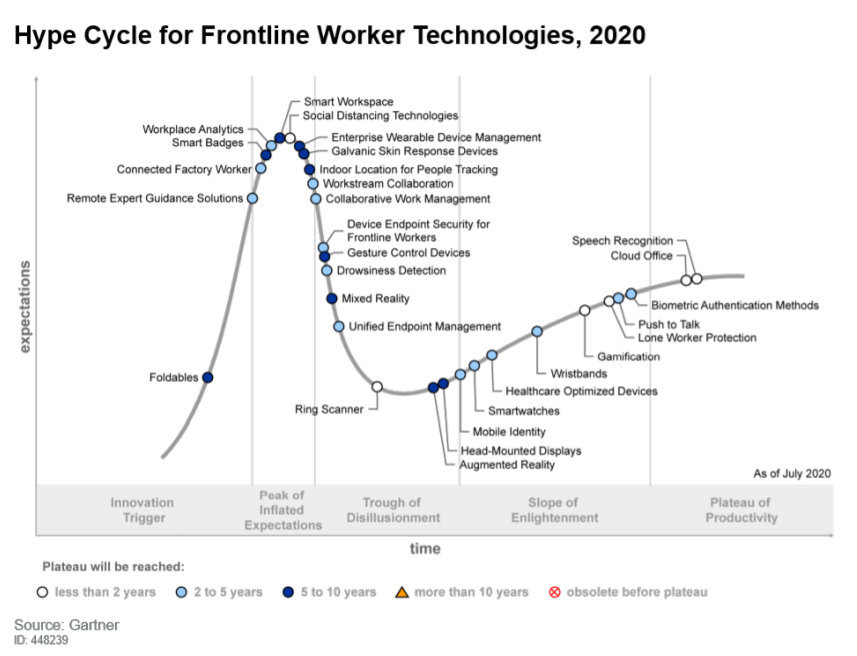Gartner highlights Social Distancing technologies as one of the technologies with the highest benefit for front-line workers expected in the next 2 years.
Front line workers are more exposed to the coronavirus, and a variety of technologies can help keep them safe. As an employer, you have a responsibility to provide workplace protections. These protective technologies can help in a variety of ways.
- Provide remote assistance via mixed & augmented reality
- Reduce the time of exposure through process efficiency
- Maintain separation from others with social distancing technologies
- Improved communication with mobile collaboration
- Automate manual tasks through speech recognition
In the report “Hype Cycle for Frontline Worker Technologies, 2020”, Gartner evaluates the readiness of many of these technologies. We believe Gartner Hype Cycles are a model of technology maturity and adoption. Maturity across a technology’s life-cycle is modeled from its inception when market visibility is low, through a peak of excitement associated with the technology, through a dip when excitement is replaced with practicality, and an eventual steady state.

As part of the analysis, Gartner considers the transformational potential of each technology and the time frame until mainstream. We believe among the technologies poised for mainstream in less than 2 years with the highest benefit are
- social distancing technologies
- speech recognition
- lone worker protection
- cloud office.
Social Distancing technologies are affordable and can be deployed quickly. Many solutions, like AiRISTA’s, include the ability to automate contact tracing in the event of a positive case. Employees wear tags that alert when minimum safe distances are exceeded. The IDs of the tags in contact are stored centrally along with the duration of the contact.
At AiRISTA, we have found that each customer has different environments and objectives. Given the nuances of each deployment, the ability to remotely configure the tag settings allow for customizations. For example
- increasing the alerting distance from 6’ to 10’ provides further protection for employees with underlying health conditions.
- In other situations, companies might to choose to save only those contacts that exceed a certain duration. The CDC recommends focusing on contacts of 15 minutes or more. Companies may choose to not save contacts of shorter duration.
- And using a “Grace Period” setting, employees that connect and separate for only a short period and come back into contact record a single contact instance consisting of the sum of the individual contacts. This Grace Period is particularly helpful when employees work closely like assembly lines and cubicle environments.
These settings are typically dialed-in by a small team preparing for the return of workers. They exercise the system, adjust the tag settings, and run reports until they get the results desired for their specific environment. AiRISTA can also share best practices of the deployments we have assisted with.
With respect to social distancing solutions, Gartner advises, “Social distancing technologies cannot provide a guarantee against infection, so organizations should set realistic expectations for the effectiveness of such tools. All are likely to generate false negatives and positives… Those deploying the technology should also be transparent about what personal data is stored, collected, and retained by such systems and how it will be used for tasks like contact tracing. However, despite the technologies’ limitations, we expect many organizations will feel that some support for social distancing is better than none, and additionally some may find their lawyers recommend them to reduce potential liability.”





